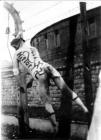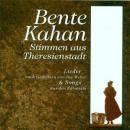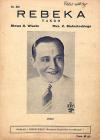כ'קלער: מענטשן האַװען הין און הער,
יעדער מענטש איז זײַן באַגער
װערט פֿון גורל געטריבן,
נאָר װאָס זשע קומט אַרױס דערפֿון?
כאָטש אין לעבן אַלץ געטאָן,
האָסט געיאָגט זיך נאָך דער זון
און אין חושך פֿאַרבליבן.
דו גיסט אַ פֿרעג,
איז די וועלט בלויז אַ מילכל?
צו װאָס דאָס געיאָג,
אָט דאָס נאַרישע שפּילכל?
װײַל מיר זײַנען װי שאָטנס,
בלאָנדזשן שטיל דורך דער נאַכט,
װײַל אין לעבן אָן ליכט
װײסט ניט װער װוּ ער קריכט,
פֿרעמד זײַן אײגן געזיכט...
יעדע טיר, יעדער לאָדן
איז פֿאַר אונדז הײַנט פֿאַרמאַכט...
װערסט פֿון אומעט געיאָגט,
קײנער פֿרעגט װאָס דיך פּלאָגט,
צי אַ האַרץ אין דיר שלאָגט!
זוכסט דײַן געזיכט, דײַן אײגן איך
נאָר קענסט עס ניט געפֿינען.
קומסט מיט דער נאַכט
און װערסט אין נאַכט צערונען.
װײַל מיר זײַנען װי שאָטנס
װאָס די נאַכט האָט צעשפּרײט,
נאָר זי אײנע פֿאַרשטײט
װוּ אַהין יעדער גײט,
װער צום לעבן – װער צום טױט.
הײַנט האָסט געטראָפֿן מיך דאָ, פֿרײַנט.
זעסט מײַן פֿרײד, װאָס האָט געשײַנט,
שױן פֿאַרשװענקט פֿון געװיטער.
כ'בין עלנט, הפֿקרדיק אַלײן,
אױפֿן װעג – אַ הױלער שטײן,
קײנער הערט ניט מײַן געװײן,
קײנעם אַרט ניט מײַן ציטער.
װי אָפֿט איך פֿאַרגעס,
אַז אין מענטש כ'בין געראָטן:
מיר דוכט כ'בין אַ מת
אָדער גאָר בלױז אַ שאָטן.
ס'װעלן שאָטנס פֿאַרשװינדן,
װעסט אין גרױקײט זען באַלד,
װי פֿון שאָטן װאָס פֿאַלט
טײלט זיך אױס אַ געשטאַלט,
װי די זון העל צעשטראַלט.
יעדער מענטש איז זײַן באַגער
װערט פֿון גורל געטריבן,
נאָר װאָס זשע קומט אַרױס דערפֿון?
כאָטש אין לעבן אַלץ געטאָן,
האָסט געיאָגט זיך נאָך דער זון
און אין חושך פֿאַרבליבן.
דו גיסט אַ פֿרעג,
איז די וועלט בלויז אַ מילכל?
צו װאָס דאָס געיאָג,
אָט דאָס נאַרישע שפּילכל?
װײַל מיר זײַנען װי שאָטנס,
בלאָנדזשן שטיל דורך דער נאַכט,
װײַל אין לעבן אָן ליכט
װײסט ניט װער װוּ ער קריכט,
פֿרעמד זײַן אײגן געזיכט...
יעדע טיר, יעדער לאָדן
איז פֿאַר אונדז הײַנט פֿאַרמאַכט...
װערסט פֿון אומעט געיאָגט,
קײנער פֿרעגט װאָס דיך פּלאָגט,
צי אַ האַרץ אין דיר שלאָגט!
זוכסט דײַן געזיכט, דײַן אײגן איך
נאָר קענסט עס ניט געפֿינען.
קומסט מיט דער נאַכט
און װערסט אין נאַכט צערונען.
װײַל מיר זײַנען װי שאָטנס
װאָס די נאַכט האָט צעשפּרײט,
נאָר זי אײנע פֿאַרשטײט
װוּ אַהין יעדער גײט,
װער צום לעבן – װער צום טױט.
הײַנט האָסט געטראָפֿן מיך דאָ, פֿרײַנט.
זעסט מײַן פֿרײד, װאָס האָט געשײַנט,
שױן פֿאַרשװענקט פֿון געװיטער.
כ'בין עלנט, הפֿקרדיק אַלײן,
אױפֿן װעג – אַ הױלער שטײן,
קײנער הערט ניט מײַן געװײן,
קײנעם אַרט ניט מײַן ציטער.
װי אָפֿט איך פֿאַרגעס,
אַז אין מענטש כ'בין געראָטן:
מיר דוכט כ'בין אַ מת
אָדער גאָר בלױז אַ שאָטן.
ס'װעלן שאָטנס פֿאַרשװינדן,
װעסט אין גרױקײט זען באַלד,
װי פֿון שאָטן װאָס פֿאַלט
טײלט זיך אױס אַ געשטאַלט,
װי די זון העל צעשטראַלט.
inviata da Bartleby + CCG/AWS Staff - 1/2/2011 - 11:02
Lingua: Yiddish
La trascrizione in caratteri latini (Si veda l'introduzione)


Leyb Rozental.
"The song is performed by Betty Segal, accompanied by Akiva Daykhes on the accordion.
The song was written by Leyb Rosental, who perished in 1945, for a review show of the Vilna Ghetto Theater entitled “Korene Yorn un Veytsene Teg” (Corn Years and Wheat Days), performed in 1943. The title is a play on the words “veytsene” – pronounced here as “vey tsu”– a cry of pain.
The song describes life in the ghetto as shadows, haunted by their destiny. The Jewish shadows – ghetto residents – live as corpses, as others continue their lives giving no thought to their pain and suffering. The lonely man – nobody listens to his cries. But one day in the future, “the shadows will disappear, and from the horrors you will see, soon, how the shadow passes and the sun shines a clear light.” The song ends in hope, as do many of the songs performed for the suffering population in the ghetto.
The sweet melody of the tango reinforces the contrast between the somber words and the song’s message, and joins them and us together – a disparity that appears in many songs from the Vilna ghetto. The tango was very popular in easy listening music in Eastern Europe and other places in the interwar years." - Heartstrings - Music of the Holocaust
The song was written by Leyb Rosental, who perished in 1945, for a review show of the Vilna Ghetto Theater entitled “Korene Yorn un Veytsene Teg” (Corn Years and Wheat Days), performed in 1943. The title is a play on the words “veytsene” – pronounced here as “vey tsu”– a cry of pain.
The song describes life in the ghetto as shadows, haunted by their destiny. The Jewish shadows – ghetto residents – live as corpses, as others continue their lives giving no thought to their pain and suffering. The lonely man – nobody listens to his cries. But one day in the future, “the shadows will disappear, and from the horrors you will see, soon, how the shadow passes and the sun shines a clear light.” The song ends in hope, as do many of the songs performed for the suffering population in the ghetto.
The sweet melody of the tango reinforces the contrast between the somber words and the song’s message, and joins them and us together – a disparity that appears in many songs from the Vilna ghetto. The tango was very popular in easy listening music in Eastern Europe and other places in the interwar years." - Heartstrings - Music of the Holocaust
SHOTNS
Kh'kler: mentshn haven hin un her,
Yeder mentsh iz zayn bager
Vert fun goyrl getribn,
Nor vos zhe kumt aroys derfun?
Khotsh in lebn alts geton,
Host geyogt zikh nokh der zun
Un in khoyshekh farblibn.
Du gist a freg,
Iz di velt bloyz a milkhl?
Tsu vos dos geyeg,
Ot dos narishe shpilkhl?
Vayl mir zaynen vi shotns,
Blondzhn shtil durkh der nakht,
Vayl in lebn on likht
Veyst nit ver vu er krikht,
Fremd zayn eygn gezikht...
Yede tir, yeder lodn
Iz far undz haynt farmakht...
Verst fun umet geyogt,
Keyner fregt vos dikh plogt,
Tsi a harts in dir shlogt!
Zukhst dayn gezikht, dayn eygn ikh
Nor kenst es nit gefinen.
Kumst mit der nakht
Un verst in nakht tserunen.
Vayl mir zaynen vi shotns
Vos di nakht hot tseshpreyt,
Nor zi eyne farshteyt
Vu ahin yeder geyt,
Ver tsum lebn – ver tsum toyt.
Haynt host getrofn mikh do, fraynt.
Zest mayn freyd, vos hot geshaynt,
Shoyn farshvenkt fun geviter.
Kh'bin elnt, hefkerdik aleyn,
Afn veg – a hoyler shteyn,
Keyner hert nit mayn geveyn,
Keynem art nit mayn tsiter.
Vi oft ikh farges,
Az in mentsh kh'bin gerotn:
Mir dukht kh'bin a mes
Oder gor bloyz a shotn.
S'veln shotns farshvindn,
Vest in groykayt zen bald,
Vi fun shotn vos falt
Teylt zikh oys a geshtalt,
Vi di zun hel tseshtralt.
Kh'kler: mentshn haven hin un her,
Yeder mentsh iz zayn bager
Vert fun goyrl getribn,
Nor vos zhe kumt aroys derfun?
Khotsh in lebn alts geton,
Host geyogt zikh nokh der zun
Un in khoyshekh farblibn.
Du gist a freg,
Iz di velt bloyz a milkhl?
Tsu vos dos geyeg,
Ot dos narishe shpilkhl?
Vayl mir zaynen vi shotns,
Blondzhn shtil durkh der nakht,
Vayl in lebn on likht
Veyst nit ver vu er krikht,
Fremd zayn eygn gezikht...
Yede tir, yeder lodn
Iz far undz haynt farmakht...
Verst fun umet geyogt,
Keyner fregt vos dikh plogt,
Tsi a harts in dir shlogt!
Zukhst dayn gezikht, dayn eygn ikh
Nor kenst es nit gefinen.
Kumst mit der nakht
Un verst in nakht tserunen.
Vayl mir zaynen vi shotns
Vos di nakht hot tseshpreyt,
Nor zi eyne farshteyt
Vu ahin yeder geyt,
Ver tsum lebn – ver tsum toyt.
Haynt host getrofn mikh do, fraynt.
Zest mayn freyd, vos hot geshaynt,
Shoyn farshvenkt fun geviter.
Kh'bin elnt, hefkerdik aleyn,
Afn veg – a hoyler shteyn,
Keyner hert nit mayn geveyn,
Keynem art nit mayn tsiter.
Vi oft ikh farges,
Az in mentsh kh'bin gerotn:
Mir dukht kh'bin a mes
Oder gor bloyz a shotn.
S'veln shotns farshvindn,
Vest in groykayt zen bald,
Vi fun shotn vos falt
Teylt zikh oys a geshtalt,
Vi di zun hel tseshtralt.
inviata da CCG/AWS Staff - 26/5/2013 - 17:13
Lingua: Italiano
Traduzione integrale italiana di Riccardo Venturi
27 maggio 2013
27 maggio 2013
OMBRE
Penso: la gente corre di qua e di là,
ogni persona è ciò che desidera
e viene spinta dal destino;
ora, che cosa ne viene?
Benché tutto sia stato fatto nella vita
ancora una volta hai anelato al sole
e sei rimasto nell'oscurità.
E ti domandi:
il mondo è un mulino a vento?
A che serve tutto questo correre,
questo stupido giochetto?
Perché siamo come ombre,
vaghiamo tacendo nella notte,
perché in una vita senza luce
non sai chi si trascina e dove,
non si riconosce neanche il proprio viso...
Ogni porta, ogni finestra
oggi per noi è chiusa...
Se sei in preda alla disperazione
nessuno chiede che ti angoscia,
se dentro di te batte un cuore!
Se cerchi il tuo volto, te stesso,
ora non puoi trovarlo.
Arrivi assieme alla notte
e nella notte vai alla deriva.
Perché siamo come ombre
che la notte ha disciolto,
e solo lei capisce
dov'è che ognuno va,
chi alla vita, e chi alla morte.
Oggi mi hai incontrato qua, amico.
Vedi la mia gioia, che risplendeva,
già spazzata via dalla burrasca.
Sono solo, smarrito, senza nessuno,
un sasso vuoto per la strada,
nessuno sente il mio pianto,
a nessuno importa il mio tremare.
E quanto spesso dimentico
che un tempo io ero un uomo:
penso di essere un cadavere
oppure soltanto un'ombra.
Le ombre scompariranno,
presto vedrai nell'orrore
come l'ombra passerà
ritornando una figura,
e come il sole splenderà luminoso.
Penso: la gente corre di qua e di là,
ogni persona è ciò che desidera
e viene spinta dal destino;
ora, che cosa ne viene?
Benché tutto sia stato fatto nella vita
ancora una volta hai anelato al sole
e sei rimasto nell'oscurità.
E ti domandi:
il mondo è un mulino a vento?
A che serve tutto questo correre,
questo stupido giochetto?
Perché siamo come ombre,
vaghiamo tacendo nella notte,
perché in una vita senza luce
non sai chi si trascina e dove,
non si riconosce neanche il proprio viso...
Ogni porta, ogni finestra
oggi per noi è chiusa...
Se sei in preda alla disperazione
nessuno chiede che ti angoscia,
se dentro di te batte un cuore!
Se cerchi il tuo volto, te stesso,
ora non puoi trovarlo.
Arrivi assieme alla notte
e nella notte vai alla deriva.
Perché siamo come ombre
che la notte ha disciolto,
e solo lei capisce
dov'è che ognuno va,
chi alla vita, e chi alla morte.
Oggi mi hai incontrato qua, amico.
Vedi la mia gioia, che risplendeva,
già spazzata via dalla burrasca.
Sono solo, smarrito, senza nessuno,
un sasso vuoto per la strada,
nessuno sente il mio pianto,
a nessuno importa il mio tremare.
E quanto spesso dimentico
che un tempo io ero un uomo:
penso di essere un cadavere
oppure soltanto un'ombra.
Le ombre scompariranno,
presto vedrai nell'orrore
come l'ombra passerà
ritornando una figura,
e come il sole splenderà luminoso.
Lingua: Ebraico
La traduzione ebraica proveniente dalla pagina dello Yad Vashem
E', come già specificato nell'introduzione, della versione ebraica di Music and the Holocaust. Anche da questa pagina la canzone può essere ascoltata in file audio. [RV]
צללים
מלים: לייב ראזענטאל
מנגינה: טנגו פופולרי
אני מהרהר: אנשים מתרוצצים הלוך ושוב,
לכל איש יש שאיפות משלו
והגורל רודף אותו,
ומה יוצא מזה?
אפילו שעשית הכול בחיים
רדפת אחרי השמש
אבל נשארת בחושך.
אתה שואל,
האם העולם הוא רק טחנת רוח?
לשם מה הריצה המהירה
והמשחק הטיפשי?
הרי אנחנו כצללים,
תועים בשקט בלילות,
כי בחיים ללא אור
לא יודעים לאן הולכים
זרים הם אפילו פנינו...
כל דלת כל תריס
חסומים ביום בפנינו...
הצער רודף אותך,
ואין מי ששואל מה מציק לך,
ואם לב פועם בקרבך!
אתה מחפש את פניך ואת עצמך
ואינך יכול למצוא.
אתה בא עם הלילה
ואתה נסחף אל תוך הלילה.
הרי אנחנו כצללים
שהלילה פיזר
ורק הוא לבדו מבין
לאן הולך כל אחד,
מי לחיים ומי למוות.
היום פגשת אותי פה, חבר.
ראה את שמחתי שהאירה,
מה הציף את עורך.
אני גלמוד, הפקר, בדד,
על אם הדרך – אבן חשופה,
אין מי ששומע את בכיי,
ולאף אחד לא אכפת שאני רועד.
לעתים קרובות אני שוכח,
שאני דומה לבן-אדם:
אני חושב שאני מת
או בכלל רק צל.
הצללים ייעלמו,
ומתוך האפור תראה בקרוב
איך הצל נופל
וממנו יוצאת דמות
כשהשמש זורחת באור נגוהות.
מלים: לייב ראזענטאל
מנגינה: טנגו פופולרי
אני מהרהר: אנשים מתרוצצים הלוך ושוב,
לכל איש יש שאיפות משלו
והגורל רודף אותו,
ומה יוצא מזה?
אפילו שעשית הכול בחיים
רדפת אחרי השמש
אבל נשארת בחושך.
אתה שואל,
האם העולם הוא רק טחנת רוח?
לשם מה הריצה המהירה
והמשחק הטיפשי?
הרי אנחנו כצללים,
תועים בשקט בלילות,
כי בחיים ללא אור
לא יודעים לאן הולכים
זרים הם אפילו פנינו...
כל דלת כל תריס
חסומים ביום בפנינו...
הצער רודף אותך,
ואין מי ששואל מה מציק לך,
ואם לב פועם בקרבך!
אתה מחפש את פניך ואת עצמך
ואינך יכול למצוא.
אתה בא עם הלילה
ואתה נסחף אל תוך הלילה.
הרי אנחנו כצללים
שהלילה פיזר
ורק הוא לבדו מבין
לאן הולך כל אחד,
מי לחיים ומי למוות.
היום פגשת אותי פה, חבר.
ראה את שמחתי שהאירה,
מה הציף את עורך.
אני גלמוד, הפקר, בדד,
על אם הדרך – אבן חשופה,
אין מי ששומע את בכיי,
ולאף אחד לא אכפת שאני רועד.
לעתים קרובות אני שוכח,
שאני דומה לבן-אדם:
אני חושב שאני מת
או בכלל רק צל.
הצללים ייעלמו,
ומתוך האפור תראה בקרוב
איך הצל נופל
וממנו יוצאת דמות
כשהשמש זורחת באור נגוהות.
inviata da Riccardo Venturi - 26/5/2013 - 17:22
×
![]()








טעקסט: לייב ראזענטאל
מוזיק: װאָלקס־טאַנגאָ
Testo: Leyb Rozental
Musica: tango popolare
Lyrics: Leyb Rozental
Music: Popular tango
Parole di Leyb Rosental sulla melodia di un tango popolare.
Testo e introduzione in inglese trovati su Heartstrings – Music of the Holocaust, dove la canzone è pure ascoltabile nell’esecuzione di Betty Segal con Akiva Daykhes alla fisarmonica.
Basti qui ricordare che Rozental fu animatore della vita culturale del ghetto di Vilnius insieme a Kasriel Broydo, con il quale - credo, visti i dati coincidenti delle biografie che compaiono su Music and The Holocaust - scrisse alcuni spettacoli musicali, come “Korene Yorn un Veytsene Teg” (“Anni di granturco e giorni di grano”), messo in scena nel 1943, e “Moyshe halt zikh” (“Moyshe, resisti!”). E con Broydo condivise pure l’atroce destino: fu annegato e mitragliato dai nazisti nelle gelide acque del Baltico all’inizio del 1945, quando la pressione dei sovietici costrinse i tedeschi a cominciare ad evacuare i lager in Polonia. Furono mesi terribili in cui la macchina di morte nazista s’imballò ma non per questo i carnefici smisero di massacrare, anzi, rabbiosi per la sconfitta e presi dalla foga di nascondere in qualche modo l’enormità incelabile dei loro crimini, costrinsero i prigionieri a terribili marce della morte in pieno inverno che non furono altro che esecuzioni di massa.
“The song was written by Leyb Rosental, who perished in 1945, for a review show of the Vilna Ghetto Theater entitled “Korene Yorn un Veytsene Teg” (Corn Years and Wheat Days), performed in 1943. The title is a play on the words “veytsene” – pronounced here as “vey tsu”– a cry of pain.
The song describes life in the ghetto as shadows, haunted by their destiny. The Jewish shadows – ghetto residents – live as corpses, as others continue their lives giving no thought to their pain and suffering. The lonely man – nobody listens to his cries. But one day in the future, “the shadows will disappear, and from the horrors you will see, soon, how the shadow passes and the sun shines a clear light.” The song ends in hope, as do many of the songs performed for the suffering population in the ghetto.
The sweet melody of the tango reinforces the contrast between the somber words and the song’s message, and joins them and us together – a disparity that appears in many songs from the Vilna ghetto. The tango was very popular in easy listening music in Eastern Europe and other places in the interwar years.”
In questo caso, al momento della ristrutturazione della pagina (26.5.2013) il testo yiddish originale in alfabeto ebraico è stato reperito dalla versione ebraica di Music of the Holocaust dello Yad Vashem di Gerusalemme. Il testo è accompagnato da una [[|traduzione ebraica]]. La trascrizione YIVO, del tutto esatta, rimane quella indicata dall'iniziatore della pagina. [RV]